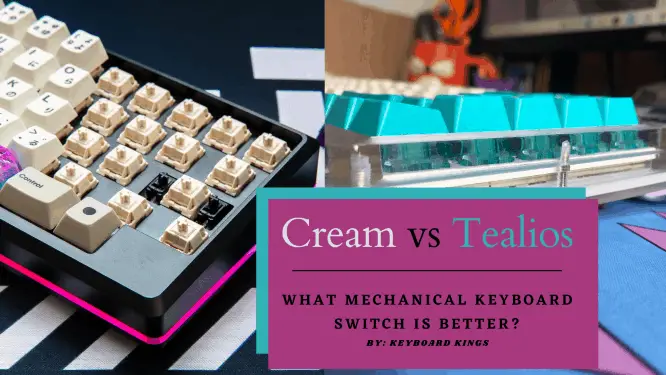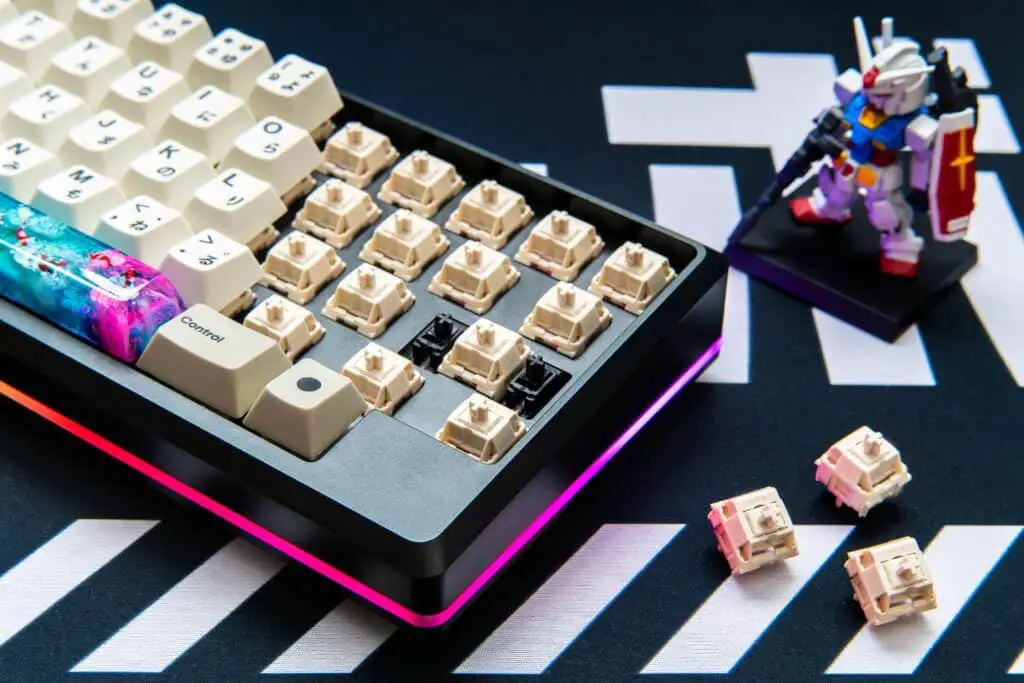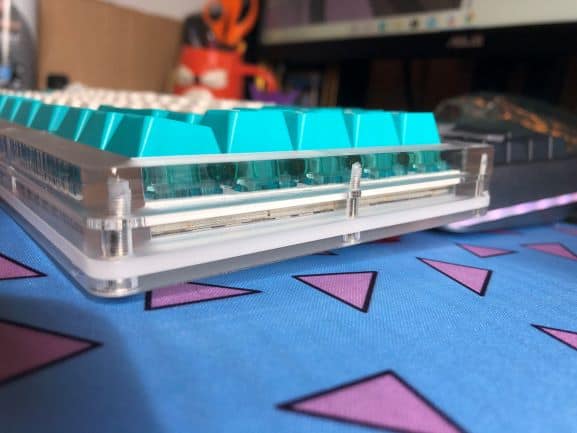Finding the right switches for you is almost as important as finding the right keyboard itself. For many of us, the switches themselves are far more important. They can make or break a keyboard.
You can get by with an ugly keyboard but it will be tough trying to get through daily life, either working or gaming, on a setup with subpar switches “click-clacking” away as you try to get some work done. Whether that’s your actual job or just defeating people online.
Some of the best switches available for a nice blend of gaming and general day to day work are linear switches. More specifically, the Cream or Telios Linear switches are some of the best on the market and would be an awesome addition to your keyboard.
There are a few similarities and differences when comparing cream switches vs tealios switches. They are both very smooth linear switches, with a medium amount of force needed for actuation. Creams are a little more expensive, but they offer “self-lubrication” and less wobble. They are also more clicky. Tealios are much more smooth then cream switches, especially with lube.
They are reasonably well known but not as commonly popular as say, some MX brands like Cherry. If you have heard of them you will have just as much to gain from this article as someone who hasn’t.
We are going to cover everything you could need to know – from the specifics of what switches are and how they work, why they matter, how to get the most out of your switch, and of course, a direct comparison between the Cream and Telios linear switches.
Oh, and we are going to cover what on earth a linear switch actually is to help you understand why you need to be using them from now on.

Table of Contents
What are Keyboard Switches?
There is a good chance you already know what a keyboard switch is if you are here, we will go over it briefly nonetheless. The switch is the point of contact between the keyboard’s PCB (printed circuit board) and the keycaps themselves.
Simply put, the switch rests more or less directly on the PCB and the keycaps rest on the switch. When you press down on the keycap the switch depresses and makes contact with the PCB.
The PCB then registers the keystroke and conveys that to the computer which in turn processes and then displays your key output. Whether that’s the character you just typed appearing in your word processor or your character in a video game moving.
The switches we are looking at today are mechanical switches, which means there is a literal physical switch that moves when pressed. Rather than, say, a membrane keyboard that makes use of a mold or perhaps some sort of pressure pads.
How Much do Switches Matter?
Switches are normally not of consequence to your average user. For example, if your keyboards at work or college are supplied by your employer or college administration there will have been little to no consideration or emphasis put on which switches you choose to use.
However, that is out of laziness or budget constraints rather than practicality. Good switches can make or break a keyboard. They can have HUGE effects on you and your productivity.
For example, high actuation linear switches will make typing so much faster, easier, and more comfortable. Choosing to use very tactile switches such as Cherry MX browns might be a huge difference-maker for someone who responds positively to the noise of typing, the rhythmic chaos can be soothing to some.
A good set of highly responsive switches can also make typing a heck of a lot less painful for someone with some kind of inflammatory issues such as arthritis where moving to type can be painful by limiting the amount of movement needed.
What are Linear Switches?
Before we get into these two sets of switches it’s important to explain what a linear switch actually is. Firstly, there are several types of switches you should be aware of. I’m not talking about membrane vs mechanical, but variations of mechanical themselves.
There are three main groups we look at here (there are more but this simplifies things). Linear, tactile, clicky, and sometimes also silent but not always.
Tactile Switch
Tactile switches give good tactile feedback when typing. They tend to have a lower point of actuation and a fair bit of spring back. They are usually not silent but can be. They are designed to give as much feedback to the user as possible, for both clarity and comfort of use.
Clicky Switch
Clicky switches are often quite loud and they tend to focus on sound. Clicky switches create loud clicking noises when they reach their point of actuation. This way you are sure whenever you press a keystroke, this improves speed and is especially helpful for people with poor eyesight. That’s not their main focus but it’s certainly worth noting.
Linear Switch
The type of switches we care about right now are linear switches. They are also often silent but that isn’t a requirement. Linear switches focus on a smooth transition from resting point to point of actuation above all else.
They are silent by default most times because they don’t stick, jam, or even rub on another surface in many cases. That’s also why they respond especially well to good, frequent, lubrication – they are silky smooth with a little love and care.
What are Cream Switches?

NovelKeys cream switches are some beautifully simplistic switches. They are very high quality and offer an almost unbelievably smooth transition if you have never used such switches before.
Cream switches are highly sought after not only for their quality but for their longevity.
A little trick for the cream switches that many people don’t know is that you don’t actually need to lubricate them yourself all that much or all that often. The plastic that they are molded from is very cleverly designed and almost lubricates itself over time.
Cream switches are pretty easy to install as they feature the same latching system as many MX switches, including cherry. This is great news if you were planning on switching directly from cherries’ to creams.
Creams operate on 2mm springs with 4mm max travel distance from rest to bottom out. According to the manufacturer, you only need 55g of pressure to reach actuation and 70g to reach bottom out.
This is great news because it means not only can you be light and gentle on the keys, but also the pressure threshold for bottoming out is considerably more. This means you won’t be hitting the keys limits very often.
Unless you’re very clumsy or aggressive with your typing. Cream switches can be around $5-7 per pack of 10. Which, for a full keyboard means you might end up paying 70 bucks for switches.
Check out Kailh Cream Switches on Amazon
What are Telios Switches?

Telios switches are by far some of the best linear switches available, in my opinion. They look great and are by far the most smooth and relatively silent options on the market. The V2s are awesome and only exceed the expectations of other models.
The switches themselves are pretty cleverly designed with a simplistic approach to a very tedious problem. They don’t make use of a huge number of parts, they instead opted for limited moving pieces to reduce the risk of jamming or sticking.
They require a very low pressure of about 67-72 grams to reach their bottom-out point. And their point of actuation. Which I don’t like, the pressure threshold should increase somewhat more in my opinion but it is what it is.
They look awesome, the color is beautiful, and they really fit the aesthetic many keyboard owners are trying to convey. That being said, if teal isn’t your color you’re screwed. Sorry.
These switches are VERY smooth in transition but do suffer from a fair bit of spring back wobble. This can be lessened or worsened depending on how loose or tight of a key layout you are working with.
You simply aren’t going to be able to find any of these switches for less than $5 per 10 pack. Again, it can start to add up if you intend to fill a full keyboard. Which I would, If I could.
Check out Tealious V2 Switches on Amazon
Comparing Cream Switches vs Tealios Switches
| Cream Switch | Tealios Switch |
|---|---|
| “Self Lubricating” | Should be Lubed |
| 55g Actuation | 67g Actuation |
| More Expensive | Cheaper |
| Louder | Quieter (with a “pop” noise) |
| Less Wobble | More Wobble |
| Less smooth | Smoother (with lube) |
| More Spring Back | Less Spring Back |
Which switch is better?
This is hard as preference plays such a huge part. But, there are some easy comparisons we can draw up. Firstly, the Tealios switches are often more affordable than their Cream counterparts. They also tend to be far quieter, while the Tealios does give a gentle pop noise off they still are far less clicky than the creams. But, the creams wobble far less.
This is a trade-off that you will have to consider for yourself when selecting your switches. If you are looking for switches purely based on how good they are linear wise, go with the Tealios. They are excellent switches and are damn near as smooth as you can get.
If you combine them with good lubricants? You genuinely couldn’t find anything smoother. I’d implore you to try because you’d have a fair few followers trying to find out your exact setup. The Tealios are smooth.
How do they stack up side by side?
Looks
Looks-wise they are very even I think. The biggest difference is that the Tealios are a little more in your face than the creams. Why? Because the cream is a very calm neutral color and vibrant teal is certainly not. Again, it really depends here what you are looking for.
Do you want switches that steal the limelight from the rest of the keyboard? Or, do you want switches that kind of blend into their background and offer only a very subtle addition to the general aesthetic of the keyboard.
Creams will go with just about any setup. The Tealios? Perhaps not quite as much.
Feel
In terms of feel, they are again, very similar. Both switches are very smooth, of course, but the general feel of the spring back is also important. The creams have a little more spring back and also feel as if they require a little more pressure to reach the bottom-out point.
Of course, they do require slightly more pressure, but, only marginally. You will notice the need to push ever so slightly harder if you are trying to bottom out the keyboard. But, you have no reason to want to do so.
The biggest factor for feel here is that the cream feels as if they start to stick after you push past the point of actuation. This isn’t a major issue but it does make the whole typing experience slightly less enjoyable.
The Tealios have no such problem as they have a constant pressure threshold from actuation to bottom out. However, some people don’t like the feel of this at all and would much rather have some kind of artificial warning you have actuated such as increased pressure.
Smoothness
We are all here for smoothness. Why else go for linear switches? In terms of smoothness, the actual comparison between the two is a little tricky. In a vacuum, the Tealios are far smoother. Not just smoother than the creams but any other keyboard switches you might use.
However, the creams are self-lubricating (to an extent) so over time they start to catch up with the Tealios. Furthermore, if you were to well lubricate either of these switches they would be far smoother than their competitor (assuming they aren’t also lubricated).
The Tealios are just about as smooth as you could hope for. With lube? They are in a league of their own.
Price
The price differential is not massive. It depends where you buy from and how many you end up buying. Of course, buying in bulk very well may get you a discount.
On average, the Tealios are about 50 cents per switch whereas the creams can be up to 70 cents. That being said, you can probably pick some creams up for about 50 cents too.
Fitting a full keyboard worth of switches will easily cost you 50 bucks. So don’t let price talk you out of one or the other, they are so darn close it honestly doesn’t matter.
Lubing your Tealios or Cream Switches can Make them Better
My biggest tip for you regarding the switches of your keyboard is that you should be lubricating them. Really, if you want a cheap and easy upgrade for your switches then lube is the way to go. Don’t get me wrong, lube won’t make a bad switch good. But, it will make a good switch great.
If you are looking for smooth actuation and the complete removal of jamming or sticking altogether then that’s the way to go. I would highly recommend that you lubricate both of these switches, regardless of which ones you end up choosing.
You don’t have to do so, both switches are pretty darn great regardless. But, why wouldn’t you? It’s easy, it’s cheap, and it makes your life easier. Most people who choose not to lube their switches do so because they just have no idea how to do it. It sounds like a difficult task, I can assure you, it’s not. This next section will make that clear.
How to lube your switches
The first step to lubrications your switches is to actually take the keyboard apart. Don’t worry, it’s not hard and it doesn’t take very long.
Most keyboards are held together by a handful of tactically placed screws. Usually between 6-12, often 8. This is good news for you because once you have removed these screws your keyboard will essentially split in half.
One half will house the keycaps and their half of the frame. The other half will hold the switches and their PCB. We are only interested in the switches.
When it comes to the actual lubrication stage of the process, it’s important to try and keep things simple for yourself. You don’t need heaps of tools and various other little filters and files. You need a small (type 00) paintbrush and the lube itself.
Simply lubricate the brush and then use the brush to evenly transfer over the switch. Each switch is different, but, the general idea is very much the same. So, you can either follow a specific YouTube guide for lubricating your specific switches or go off of this general simple instruction.
You need to lubricate everything on the switch, but, focus your attention on the actual switch mechanism. Work slowly, methodically, and evenly. Almost counterintuitively having some switches better lubricated than the others is as bad as having none lubricated at all. Worse even, because there is no consistency. Consistency is key. Consistency is speed.
Conclusion
Of course, there is more to consider here when deciding which are right for you. Style matters. If teal doesn’t fit your aesthetic but the cream does, go with the cream.
On the flip side, if the style doesn’t matter it’s naive to assume that only smooth transition does. Maybe the wobble throws you off. Maybe you don’t like the pop noise the Tealios make. Maybe, you aren’t interested in either because you feel priced out.
Again, a lubricant is the best way to get more out of your keyboard. Well lubricated cream switches will be far smoother than unlubricated Tealios ones. Regardless, I hope you find joy in whatever switches you choose. Good luck with your pursuit of the perfect keyboard. Happy typing!

